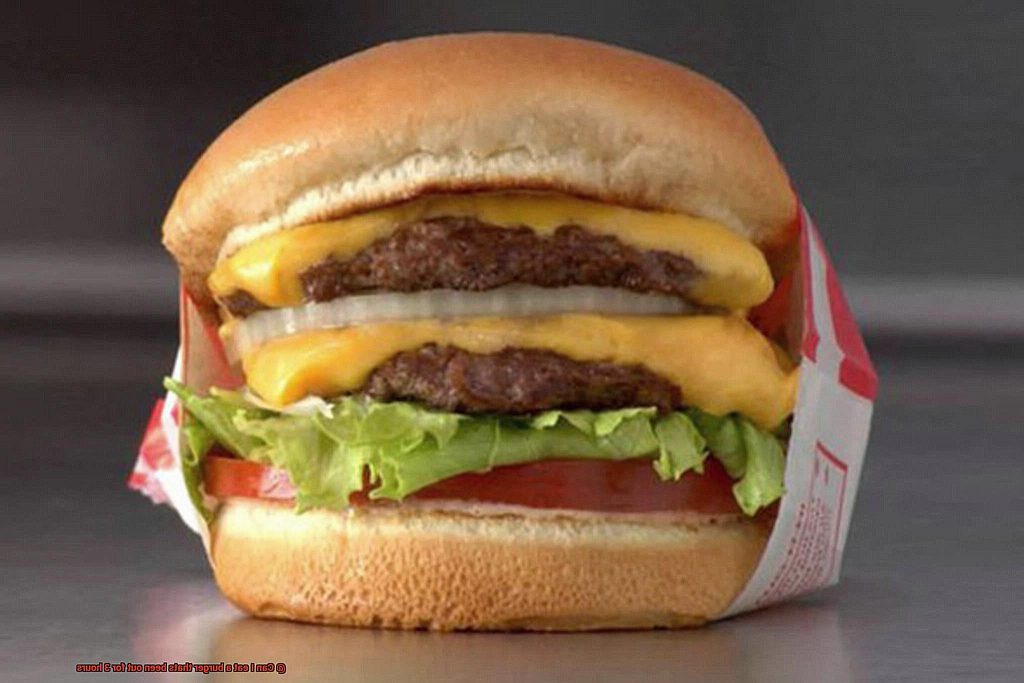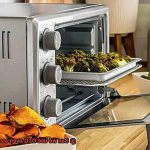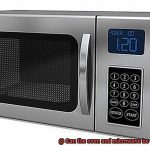Ah, the beloved burger – a fast food staple that satisfies our cravings like no other. Whether you’re a fan of the classic cheeseburger or prefer something more gourmet, there’s no denying the allure of a juicy patty nestled between two soft buns. But what happens when your burger has been sitting out for a few hours? Are you risking your health by taking a bite, or should you just toss it in the trash and start over?
It’s a question that many of us have pondered at some point in our fast food-loving lives. Maybe you got distracted by a meeting or lost track of time while chatting with friends. Whatever the reason, we’ve all found ourselves staring down at a once-perfect burger wondering if it’s still safe to eat.
In this blog post, we’re diving deep into the science behind food safety to answer one burning question: can you eat a burger that’s been out for three hours? We’ll explore everything from the temperature danger zone to the risks of bacterial growth so that you can make an informed decision about whether to chow down on that delicious burger or not. Plus, we’ll dish out some tips for keeping your fast food fresh and tasty so that you don’t have to worry about any future food-related dilemmas.
So buckle up and get ready to learn all about whether that burger is still good to go.
Contents
What is the Danger Zone?
The Danger Zone is a temperature range between 40°F and 140°F (4.4°C and 60°C) in which harmful bacteria can multiply rapidly, leading to foodborne illness. This makes it crucial to keep perishable foods, including meats, dairy, and cooked foods, out of this temperature range.
When it comes to burgers, they must be cooked to an internal temperature of 160°F to eliminate any harmful bacteria. If left out for more than two hours, burgers are likely to have been in the Danger Zone for some time. Bacteria can double in number every 20 minutes at room temperature, which means that any harmful bacteria present on the burger could have multiplied significantly during this time.
It is important to note that not all bacteria are harmful, and some types can even be beneficial. However, certain strains of bacteria like Salmonella and E. coli can cause severe illness if consumed in large enough quantities. Therefore, handling and storing food correctly is crucial to minimize the risk of foodborne illness.
To ensure food safety, there are several tips to follow:
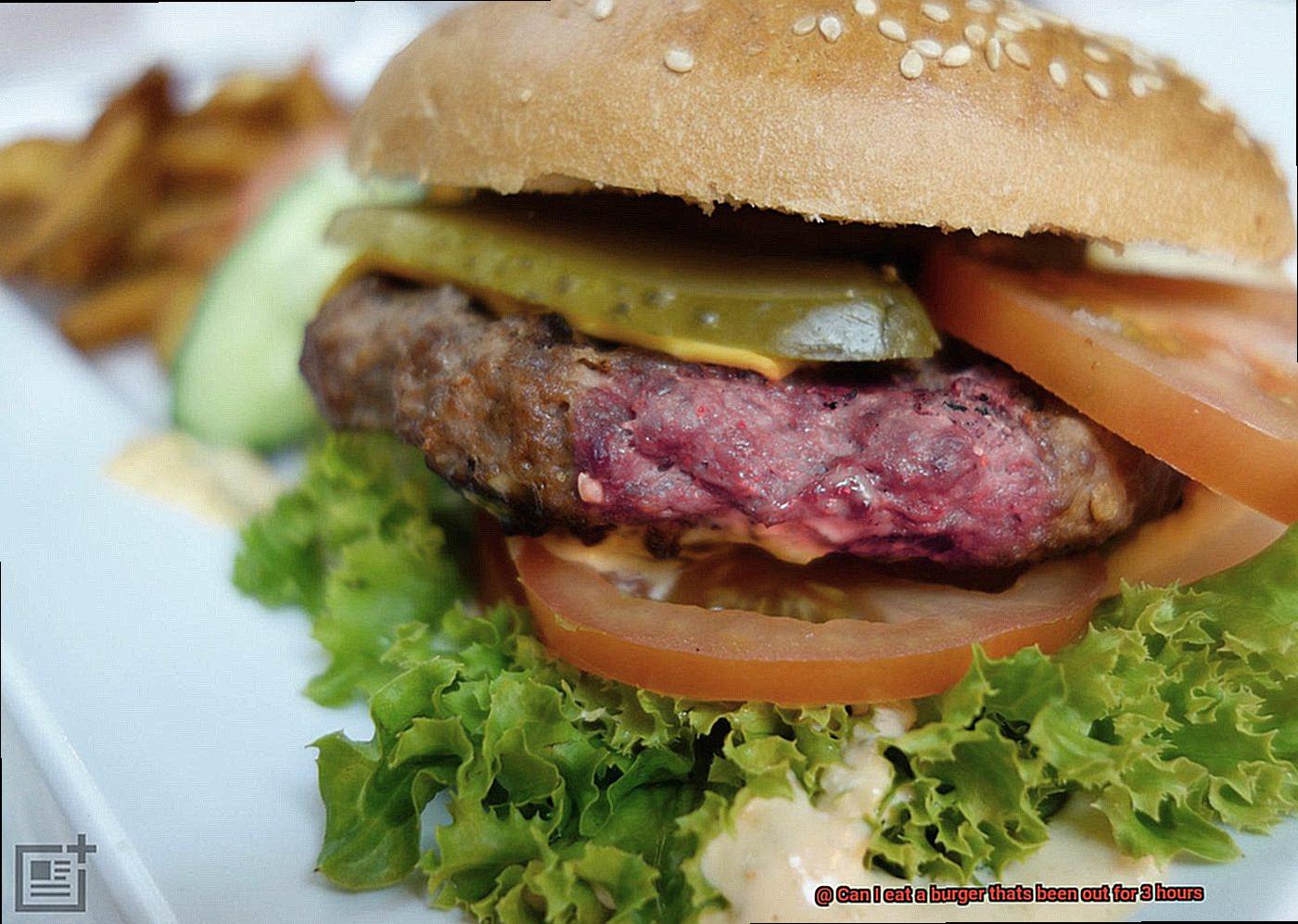
- Keep perishable foods out of the Danger Zone.
- Cook food to the appropriate internal temperature.
- Store food at the correct temperature.
- Use safe handling practices when preparing and serving food.
- When in doubt, throw it out.
By adhering to these simple guidelines, you can help keep yourself and your loved ones safe from foodborne illness.
The 2-Hour Rule
One of the most important guidelines to follow when handling perishable foods like burgers is the 2-hour rule.
The 2-hour rule is a widely accepted food safety guideline that states that any perishable food left out at room temperature for more than two hours should be thrown away. This is because bacteria love warm and humid conditions and can multiply rapidly on food that has been left out for too long.
Bacterial growth can lead to foodborne illness, which can cause symptoms like nausea, vomiting, diarrhea, and even fever. These symptoms can last anywhere from a few hours to several days. Therefore, it’s essential to follow the 2-hour rule to avoid any potential risks.
It’s important to remember that temperature plays a significant role in bacterial growth. According to the United States Department of Agriculture (USDA), any food left out at temperatures between 40°F and 140°F for more than two hours should be discarded. However, factors such as the room temperature and the condition of the burger can affect how quickly bacteria multiply. Therefore, it’s best to err on the side of caution and discard any food that has been left out for too long.
Proper storage and cooking practices are also crucial to prevent foodborne illness. You should always store perishable foods like burgers in a refrigerator or cooler until they’re ready to be cooked or consumed. When cooking burgers, make sure they reach an internal temperature of 160°F to kill any harmful bacteria.
Temperature Considerations
It may seem like a small detail, but it plays a crucial role in ensuring the safety of your food.
Bacteria growth is a significant concern when it comes to burgers. Any perishable food, including burgers, left at room temperature for more than two hours is at risk of bacterial growth. The danger zone for bacterial multiplication is between 40°F and 140°F. In this temperature range, bacteria can multiply quickly, leading to spoilage and potential foodborne illnesses. So if you’ve left your burger out for three hours or more, it’s best to toss it away instead of taking any chances.
Apart from the time factor, the internal temperature of the patty is just as important. The United States Department of Agriculture (USDA) recommends cooking ground beef to an internal temperature of 160°F to kill any harmful bacteria present in the meat. Once you’ve cooked your burger to the recommended temperature, keep it hot or refrigerated until serving time.
It’s also essential to follow proper storage and handling practices before and after cooking. Raw meat should always be kept separate from other foods to avoid cross-contamination. Ensure that you wash your hands and surfaces thoroughly before and after handling raw meat. And don’t forget the food thermometer – it’s your best friend when it comes to ensuring that your burger is cooked to a safe internal temperature.
Cooking the Burger Properly
First things first, cooking your burger to the proper temperature is key. Ground beef should be cooked to 160°F to eliminate any harmful bacteria that can be present in the meat. To reach this temperature, cook your burger thoroughly on both sides and avoid leaving any pink in the center. A meat thermometer is a great tool to ensure your burger has reached the correct internal temperature.
While it may be tempting to press down on your burger while cooking, resist the urge. Doing so will release the flavorful juices and result in a dry and unappetizing burger. Instead, let it cook undisturbed until it’s perfectly cooked.
Once your burger is cooked to perfection, serve it immediately or keep it warm until ready to eat. Leaving a cooked burger out at room temperature for more than two hours can increase the risk of bacterial growth and foodborne illness. If you have leftovers, store them promptly in the fridge.
To summarize, follow these essential steps for cooking the burger properly:
- Cook your burger thoroughly to 160°F
- Use a meat thermometer to check internal temperature
- Avoid pressing down on your burger while cooking
- Serve immediately or keep warm until ready to eat
- Store leftovers in the fridge promptly
Factors That Affect Food Safety
As an expert on food safety, I am here to enlighten you on the critical factors that can impact the safety of your burgers.
Temperature is one of the most crucial factors that can affect food safety. Bacteria thrive in temperatures between 40°F and 140°F, which is known as the danger zone for bacterial growth. When a burger is left out for three hours, it is exposed to temperatures within this range. This exposure makes it more susceptible to bacteria and increases the risk of foodborne illness. To prevent this, store your burger in the fridge or freezer to keep it at a safe temperature.

Moisture is another essential factor that affects the safety of your burger. When a burger loses moisture, it becomes dry and unappetizing. More importantly, moisture promotes the growth of bacteria and microorganisms that can cause foodborne illnesses. To prevent this, store your burgers in a sealed container or wrap them tightly in plastic wrap.
The handling and preparation of your burger also play a significant role in determining its safety. If your burger was not cooked thoroughly or was contaminated during preparation, it poses a risk of foodborne illness. Always follow proper handling and preparation techniques when cooking burgers to ensure their safety. Use a meat thermometer to ensure your burgers are cooked to an internal temperature of 160°F.
Potential Health Risks of Eating a Burger Left Out for 3 Hours
As a food safety expert, let me tell you about the potential health risks of consuming such a burger.
The first and foremost concern is the risk of foodborne illness. Harmful bacteria like E. coli and Salmonella thrive in warm, moist environments – exactly like a burger that has been left out between 40°F and 140°F for too long. The bacteria can quickly multiply and turn your burger into a breeding ground for potential illness.
But don’t be fooled by its appearance and smell – even if the burger looks and smells fine after being left out for several hours, it doesn’t necessarily mean it’s safe to eat. Harmful bacteria can proliferate without any visible signs of spoilage.
Consuming contaminated food can lead to various unpleasant symptoms, including nausea, vomiting, diarrhea, fever, and abdominal cramps. In severe cases, food poisoning can even be life-threatening, especially for young children, pregnant women, and individuals with weakened immune systems.
To avoid these potential health risks, here are some tips:
- Keep perishable items refrigerated or properly heated until you’re ready to eat them.
- Discard any food that has been left out at room temperature for more than two hours.
- Cook your burgers thoroughly – to 160°F or higher – to kill off any potential bacteria that might be lurking inside.
When in Doubt, Throw it Out.
It’s always better to be safe than sorry.
Why is this advice so crucial? Well, food left out at room temperature for more than two hours can become a breeding ground for harmful bacteria to multiply. And ground beef, which is commonly used for burgers, is particularly susceptible to contamination.
When beef is ground up, any bacteria that were on the surface of the meat are now mixed throughout the entire batch. Furthermore, burgers are often cooked at lower temperatures than other meats, which means that any bacteria present may not be entirely killed off during the cooking process.
So, what can you do to minimize the risk? First and foremost, ensure that your burgers are cooked thoroughly. Use a food thermometer to check their internal temperature and ensure that it reaches 160°F (71°C). This will help to kill off any harmful bacteria present and make your burger safe to eat.
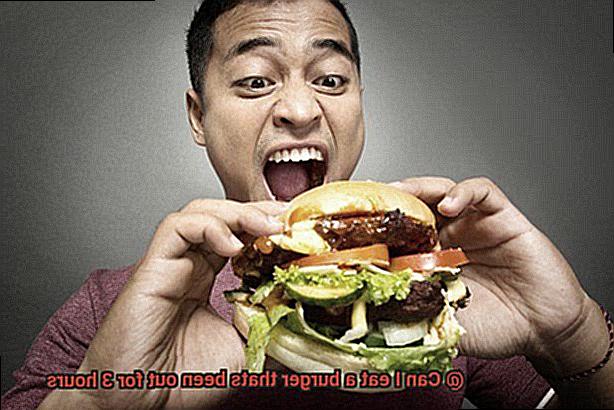
Secondly, store any leftovers in the refrigerator within two hours of cooking. This will prevent bacteria from multiplying and causing illness.
However, if you’re still unsure about the safety of a particular burger, always remember – when in doubt, throw it out. Even if it looks and smells fine, there’s no guarantee that it’s safe to eat.
Tips for Keeping Burgers Safe and Delicious
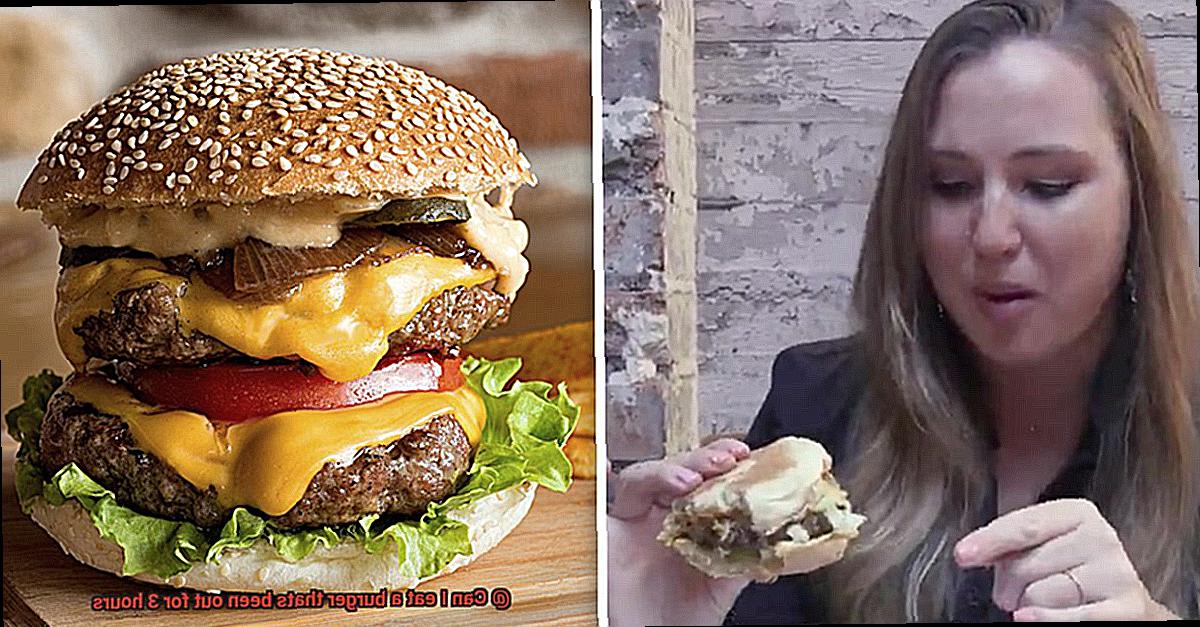
The USDA recommends cooking ground beef to an internal temperature of 160 degrees Fahrenheit to kill any harmful bacteria that may be present. However, this is just the first step in ensuring that your burgers are both tasty and safe.
To keep your burgers safe and delicious, it’s crucial to keep your meat refrigerated until it’s time to cook. This helps prevent bacteria from growing on the meat and reduces the risk of foodborne illness. When grilling burgers, make sure they stay cold until you’re ready to cook them. This means taking them directly from the fridge to the grill without allowing them to sit out at room temperature.
After cooking your burgers, serve them immediately or keep them hot by placing them in a warming tray or on a heated grill rack. Leaving your burgers out at room temperature for too long can increase the risk of harmful bacteria growth. If burgers have been out for more than two hours (or one hour if the temperature is above 90 degrees Fahrenheit), they should be discarded.
Storing leftover burgers is also important for food safety. Refrigerate leftovers within two hours of cooking and consume within three to four days. If you’re unsure about the safety of your leftover burgers, it’s best to err on the side of caution and discard them. When reheating leftover burgers, make sure they are heated to an internal temperature of 165°F before consuming.
When grilling burgers outside, use clean utensils and plates when handling raw meat to avoid cross-contamination. This helps prevent the spread of harmful bacteria and ensures that your burgers remain safe and delicious.
Conclusion
In conclusion, the safety of a burger left out for three hours hinges on the temperature danger zone. This zone, between 40°F and 140°F, is where bacteria thrive. To eliminate harmful bacteria, burgers must be cooked to an internal temperature of 160°F. Leaving burgers at room temperature for more than two hours can increase the risk of foodborne illness due to bacterial growth.
To ensure safe consumption of burgers, it’s vital to follow proper storage and handling practices before and after cooking. Always store perishable foods such as burgers in a refrigerator or cooler until ready for cooking or consumption. When cooking burgers, make sure they reach an internal temperature of 160°F to kill any harmful bacteria present in the meat.
In summary, when faced with the question “Can I eat a burger that’s been out for three hours?” it’s best not to take any chances. Discard any food left out for too long instead of risking potential health issues.

